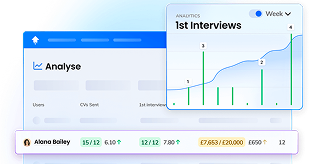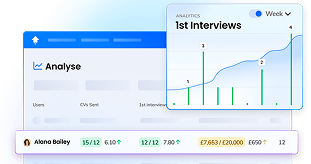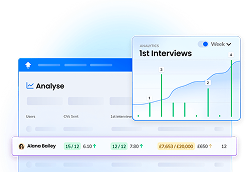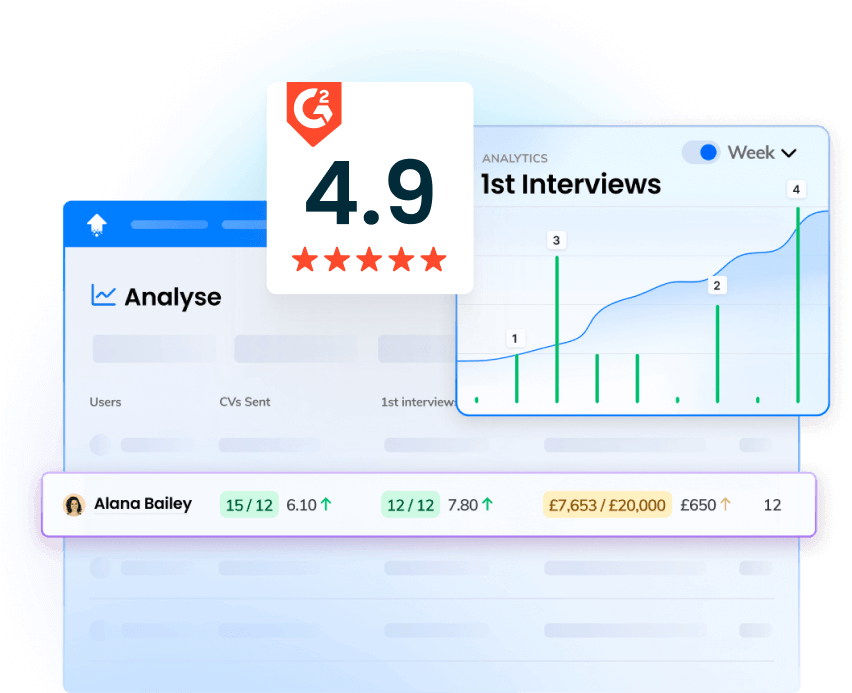7 Strategies to Measure Recruitment Effectiveness
The importance of meticulously measuring recruitment effectiveness is evident.
Here are seven useful strategies for getting it right.
1. Define Recruitment Goals
A recruitment strategy can only be as effective as the goals it's measured against.
Without clear, well-defined SMART goals, your recruiters have nothing to strive for — and you have no way to measure performance.
So, to measure the effectiveness of your recruitment strategy, you must always start with your goals.
First, review your business strategy and roadmap for the future and set several clear business goals.
How do you know if these are the right goals for your business?
One simple question:
If you hit each goal, will your business be closer to where you want it to be?
Once you've set your business goals, it's time to set goals for your leaders, managers, and recruiters.
To unlock performance-based recruitment, consider what they would need to contribute to your recruitment efforts for you to hit your overall business goals.
Furthermore, take into account their strengths and weaknesses and personal development ambitions.
Remember — recruitment leaders must always set SMART goals that are:
- Specific
- Measurable
- Achievable
- Relevant
- Time-bound
Here's what a SMART goal looks like:
Send [X number] of CVs to [Y customer] by [Z date].
Here's what not to do:
Send more CVs in the coming months.
2. Structure Recruitment KPIs
Once your goals are defined, you must determine how best to measure them.
This is where your key performance indicators come in.
Recruitment KPIs are metrics that agencies use to measure their effectiveness.
These metrics give recruiters an idea of what's going well, which areas need improvement, and how they are progressing toward their goals.
The KPIs you use will depend on your goals.
In the simple example above, where a recruiter has been instructed to send [X number] of CVs to [Y client] by [Z date], your metric would be CVs sent.
Venturing deeper into the data, you could isolate the CVs metric to only the recruiter and the client, clearly showing how close the team member is to achieving their target.
Of course, as your goals become more complex, so do your KPIs.
For instance, say you'd set the following business goal:
Generate [£X amount] in overall agency revenue by the end of the year.
There are obvious metrics to track here, such as overall revenue generated and revenue per recruiter.
However, you should cross-reference this data with other metrics, such as jobs added, time to hire, and average placement value.
Why?
Tracking these metrics reveals a more accurate picture of future revenue.
Then, you can take swift action if you discover you're not on track to hit your goal.
3. Ensure Team Visibility and Understanding
When it comes to how to measure effectiveness of recruitment and selection processes, buy-in is crucial.
You need to work hard to communicate precisely why measuring recruitment effectiveness is so important to the agency.
It's also vital that the information is democratised so that all stakeholders can easily access and understand the data.
This means using collaborative data analytics tools with clear visualisations that you don't need to be a data scientist to interpret.

Why is buy-in so important?
When launching your recruitment measurement project, other stakeholders in your business will be required to learn how to use new tools and complete additional work.
They need to fully understand the importance of this work to the overall success of the agency — and themselves — or it risks slipping to the bottom of the pile.
When selecting your data analytics tools, remember to choose user-friendly, intuitive software that everyone in your organisation will actually enjoy using.
Complex, clunky, or time-consuming data tools are a surefire way to deter your team from engaging with the measurement initiative.
4. Business Impact of Recruitment
To engage more senior stakeholders in measuring recruitment effectiveness, go for the bottom line.
Use data analytics tools that clearly and visually demonstrate the correlation between recruitment practices and business health.
Specifically by measuring the effectiveness of your recruitment processes and subsequently improving them, revenue will increase, and costs will drop.
Create custom dashboards displaying this correlation, and make them the centre point of meetings surrounding recruitment strategy.
Constantly refer back to these dashboards in order to embed a culture of data-driven decision-making within your organisation.
5. Leverage Recruitment Analytics Technology
So how to evaluate recruiter performance?
Recruitment leaders must utilise cutting-edge technologies to deliver enhanced data insights and outstanding visualisations.
Traditionally, anything related to data, analysis, and measurement was incredibly time-consuming and the domain of expert data scientists.
But thanks to tech innovations, key data insights are now accessible to all — and they're quick and easy to access, too.
This makes it much easier to measure hiring efforts than just a few years ago.
Wondering how to set up recruitment analytics yourself?
This is where advanced new technology comes in.
With intelligent software fuelled by automation and AI, manual data entry into endless, indecipherable spreadsheets is a thing of the past.
Recruitment analytics platform OneUp empowers teams to visualise data in real time.
This software automatically pulls real-time data from your existing tech stack, including your recruitment CRM, VoIP platform, timesheets, and social media.
So, when users create custom dashboards or reports, they are automatically populated and updated without any extra manual work.
6. Regular Feedback on the Recruitment Process
Create a continuous feedback loop for your recruitment process, and then use it to regularly refine and optimise recruitment strategies.
Much of this feedback will be quantitative, gleaned from your data analytics tool.
If, for example, you see solid evidence of an ongoing bottleneck around the first interviews stage of your recruitment funnel, you'll want to hone your processes to resolve this.
But it's also important to actively seek out feedback from customers, candidates, and recruiters on how your process is running.
This can be built into workflows in several ways, such as:
Meetings scheduled with hiring managers after a placement has been made
Email surveys distributed to all candidates who have used your agency
One-to-one and group discussions with recruiters on what they believe is working well and what is failing within recruitment processes.
Gathering the feedback is only half of the challenge.
This feedback must now be analysed to reveal critical insights to improve recruitment processes.
Of course, once your changes have been implemented, you need to measure their effectiveness.
This is why it's crucial to build the infrastructure within your workflows to enable a continuous feedback loop.
7. Continuous Comparison and Reflection
Finally, schedule a time every month for a thorough review of your recruitment processes and your plans for the future.
How effective have your processes been over the past month?
What effect has the last set of changes you made had on business?
Where can your processes be honed further?
When considering your plans, don't look at them in isolation.
Instead, consider how similar tactics have worked in the past and the likely outcome of implementing these plans.
























